
95% of researchers rate our articles as excellent or good
Learn more about the work of our research integrity team to safeguard the quality of each article we publish.
Find out more
ORIGINAL RESEARCH article
Front. Mar. Sci. , 27 October 2022
Sec. Marine Affairs and Policy
Volume 9 - 2022 | https://doi.org/10.3389/fmars.2022.1001181
This article is part of the Research Topic New Frontiers of Marine Governance in the Ocean Decade View all 12 articles
In 2007 the European Union (EU) launched the Blue Book introducing the Integrated Maritime Policy (IMP) for the sustainable growth of the coastal regions of Member States. The IMP has several cross-cutting areas of intervention such as the Blue Growth Strategy, Maritime Spatial Planning, and Strategies for maritime basins. To ensure this policy’s implementation, the European Commission requested its coastal members to develop integrated maritime strategies. Furthermore, within the United Nations Decade of Ocean Science for Sustainable Development, it is also a priority of the EU to ensure compliance with the 2030 Agenda, in particular the SDG14. This study focuses on countries from the Atlantic Basin, namely France, Ireland, Portugal, Spain, and the UK (before Brexit) comparing key priorities and objectives of national ocean strategies of these countries and how they match IMP guidelines and the 2030 Agenda. The results show that one of the main focuses of these strategies is the mitigation and adaptation to climate change and nature conservation. On the other hand, desalination, exploration and prospection of oil and gas are the socioeconomic sectors of smaller significance. This study also demonstrated that Spain and UK’s ocean strategies cannot be considered as a national ocean strategy in the IMP concept. The national ocean strategy of Ireland was introduced almost 10 years ago, therefore can be considered outdated in several dimensions. France and Portugal are the only countries whose national ocean strategies are aligned with the objectives of the Atlantic Action Plan and the only ones that truly follow the guidelines of the EU Integrated Maritime Policy.
The thousands of kilometers of coastline in Europe make its economy and quality of life reliant on its maritime territory. With the increasing pressure and competition from the Member States (MS) for marine resources, the European Commission (EC) released the ‘Green Paper’ in 2006. This document was intended to develop an Integrated Maritime Policy (IMP) among the MS, to affirm the European Union (EU) as a sustainable community (EC, 2006; Moreira and Bravo, 2019). The concept of an IMP was introduced the following year, during the Portuguese Presidency of the EU Council, in the so-called ‘Blue Book’. In this document, the EC requests for maritime affairs to be treated holistically and, for this, asked the MS to develop integrated national maritime policies (EC, 2007; Meiner, 2010; Moreira and Bravo, 2019; Santos, 2021). For the effective elaboration of integrated actions, the ‘Blue Book’ established three horizontal tools for Integrated policy-making for the IMP: a European Maritime Surveillance Network, Maritime Spatial Planning (MSP) and Integrated Management of Coastal Zones (ICZM) and the compilation of data and information (EC, 2007; Chintoan-Uta, 2014; Santos, 2021). In 2008, within the framework of the MSP, the EC launched the publication ‘Roadmap for Maritime Spatial Planning: Achieving Common Principles in the EU’, a guide for the implementation of the MSP in the territories of the MS (EC, 2008).
In 2009, two years after the launch of the ‘Blue Book’, of the 65 actions proposed by it, around 56 had already been initiated, which proved the success of the implementation of the IMP (EC, 2009; Meiner, 2010; Chintoan-Uta, 2014). In 2012, in Cyprus, the European agenda for growth and job creation in the marine and maritime sectors was adopted, transcribed in the ‘Limassol Declaration’. This declaration resulted in two more planning instruments for the IMP: the ‘Blue Growth Strategy’ and the ‘Sea Basins Strategy’ (EC, 2012; Guerreiro, 2021; Santos, 2021). The ‘Blue Growth Strategy’ is a long-term strategy aiming to “harness the untapped potential of Europe’s oceans, seas, and coasts for jobs and growth”. This way, it expects that maritime economic activities are developed sustainably and in a ‘Blue Economy’ perspective (EC, 2012).
The main goal of the Sea Basin Strategies is to sustainably develop the maritime economy of countries that share the same geographic region, of all the seas and oceans of the EU. These strategies are therefore developed specifically for each region and according to its intrinsic characteristics. There are seven sea basin strategies within the scope of the IMP: Baltic Sea, Black Sea, Atlantic, Adriatic, Ionian Region, Arctic, and EU Outermost Regions1. The European Union Strategy for the Atlantic Area was originally incorporated by France, Ireland, Portugal, Spain, and the UK, with the UK no longer being part of it after Brexit (EC, 2011). The Atlantic region is the foundation for traditional activities such as aquaculture, fishing, shipbuilding, tourism, and transport, but it also reveals enormous potential for renewable energy and marine biotechnology (EC, 2011; EC, 2013; Fernández-Macho et al., 2015; Calado et al., 2019). As a way of guaranteeing the sustainable development of these sectors, this sea basin strategy defined its first Action Plan for a Maritime Strategy in the Atlantic Region (EC, 2013). In 2017 it was revised, concluding that it had a positive impact in all the constituent countries2. In 2020, this plan was updated to the Atlantic Action Plan 2.0, which aims to develop the blue economy of Spain, France, Ireland, and Portugal, in line with the preservation of the marine environment and contributing to the mitigation of climate change (EC, 2020).
As mentioned above, in the EU, the notion of National Ocean Strategies was introduced in 2007, within the framework of the IMP. The EC asked its MS to develop integrated national maritime policies, and for that purpose proposed a set of guidelines for the elaboration of National Ocean Strategies (EC, 2008; Meiner, 2010). These guidelines included the implementation of MSP plans, the adoption of the Marine Strategy Framework Directive (MSFD), the need to ensure a link between science and policy decisions, integrated maritime surveillance coordinated between MS, the definition of national and regional authorities in this area, and the need to obtain reliable and comparable data on the different maritime policies of MS (EC, 2008; Meiner, 2010; Marques, 2022). The economic perspective of the IMP was only introduced with the emergence of the ‘Blue Growth Strategy’, which plays a fundamental role in the National Ocean Strategies, as it ensures the financing of measures that contribute to the implementation of the IMP (Santos, 2021).
The main purpose of this paper is to identify the key priorities and objectives of national ocean strategies of countries belonging to the European Union Strategy for the Atlantic Area (for this study, the UK was considered before Brexit). It is also intended to understand if these priorities and objectives match IMP guidelines and the goals of the UN 2030 Agenda for Sustainable Development. Additionally. The study also aims to understand how the selected countries approach the European Union Strategy for the Atlantic Area and its Action Plan.
The present study consists of four methodological steps:
1. France, Ireland, Spain, Portugal, and the UK were selected as the case studies once they share the same area of the Atlantic Basin as EU members (Figure 1). As such, they are included in the ‘EU Strategy for the Atlantic Area’ and consequently involved in the ‘Action Plan for a Maritime Strategy in the Atlantic Region’. Then, a survey of National Ocean Strategies or equivalent legislation of the selected countries was carried out, through bibliographic research and by questionnaires sent to the representatives of each MS that are part of the European group dedicated to the implementation of the European Union Strategy for the Atlantic Area. Afterward, the most relevant socio-economic sectors in the context of the Atlantic Basin were identified (Figure 2). This selection was based on the work developed by Foley et al. (2014) and in the study “Hypercluster da Economia do Mar” (SAER - Sociedade de Avaliação Estratégica de Risco, 2009). Following, the measures and objectives of each National Ocean Strategy were grouped according to the identified socio-economic sectors.
2. A survey of the guidelines of the IMP and the Blue Growth Strategy was carried out. This survey was performed through bibliographic research in the official documents of the EC. A survey of the national legislation of each case study was also carried out, for the MSP and MSFD. The measures and objectives of each case study, collected in the first methodological phase, were then grouped according to the guidelines of the IMP (Figure 3) and the Blue Growth Strategy (Figure 4).
3. At this stage, a detailed review of all 17 SDGs of the 2030 Agenda and their respective targets was carried out, to select the SDGs and targets that meet the objectives and measures of each National Ocean Strategy. This selection allowed the categorization of the objectives and measures of each case study, according to their relevance to the achievement of each SDG and respective goals. The objectives and measures of each National Ocean Strategy were further grouped according to the 10 key challenges of the Decade of Ocean Sciences for Sustainable Development.
4. In the fourth and final stage, the data obtained in the first stage of this study were crossed with the objectives of the Atlantic Action Plan 2013-2020 and the new Atlantic Action Plan 2.0
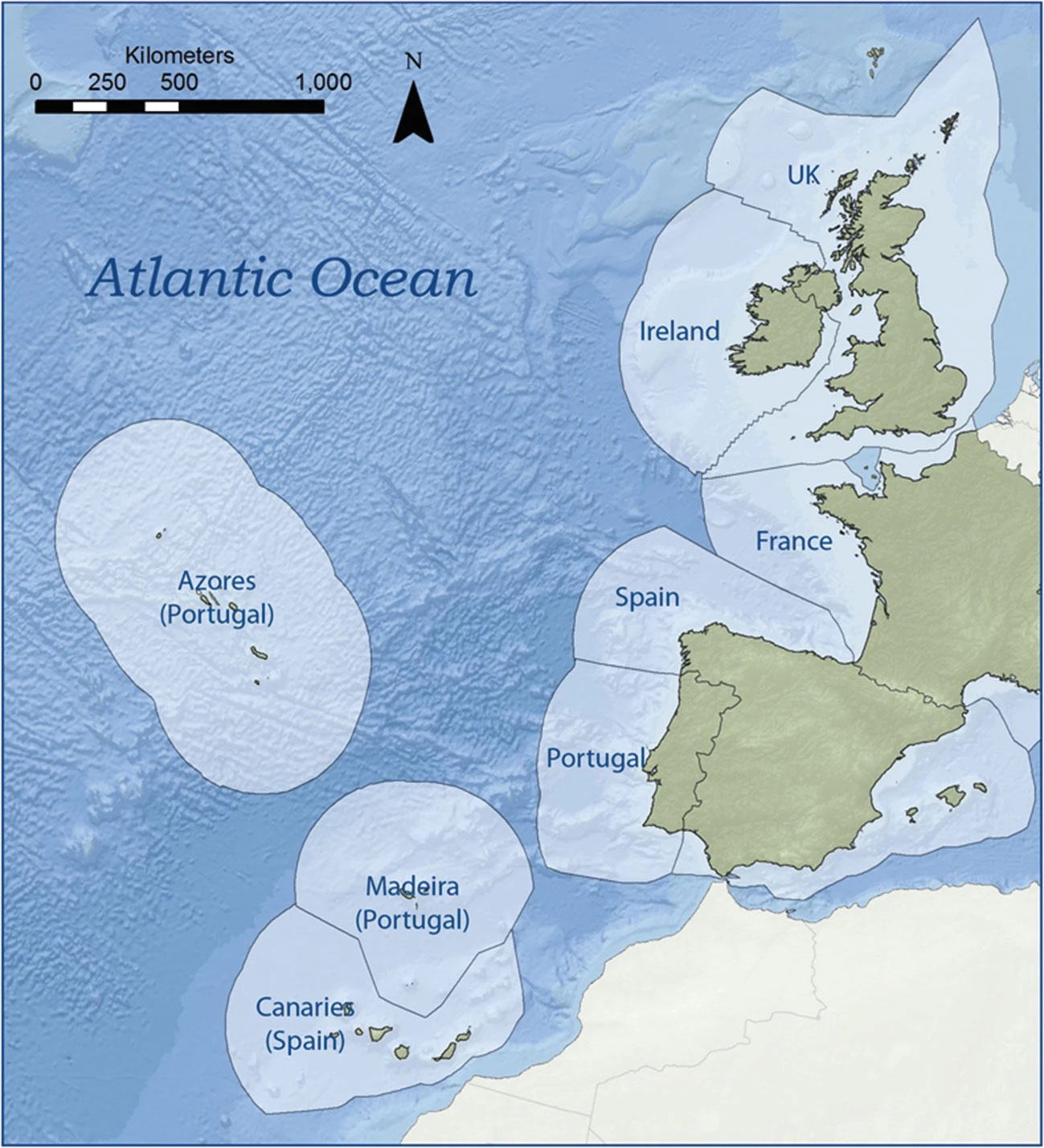
Figure 1 Location of the study area (Twomey and O’Mahony, 2019).
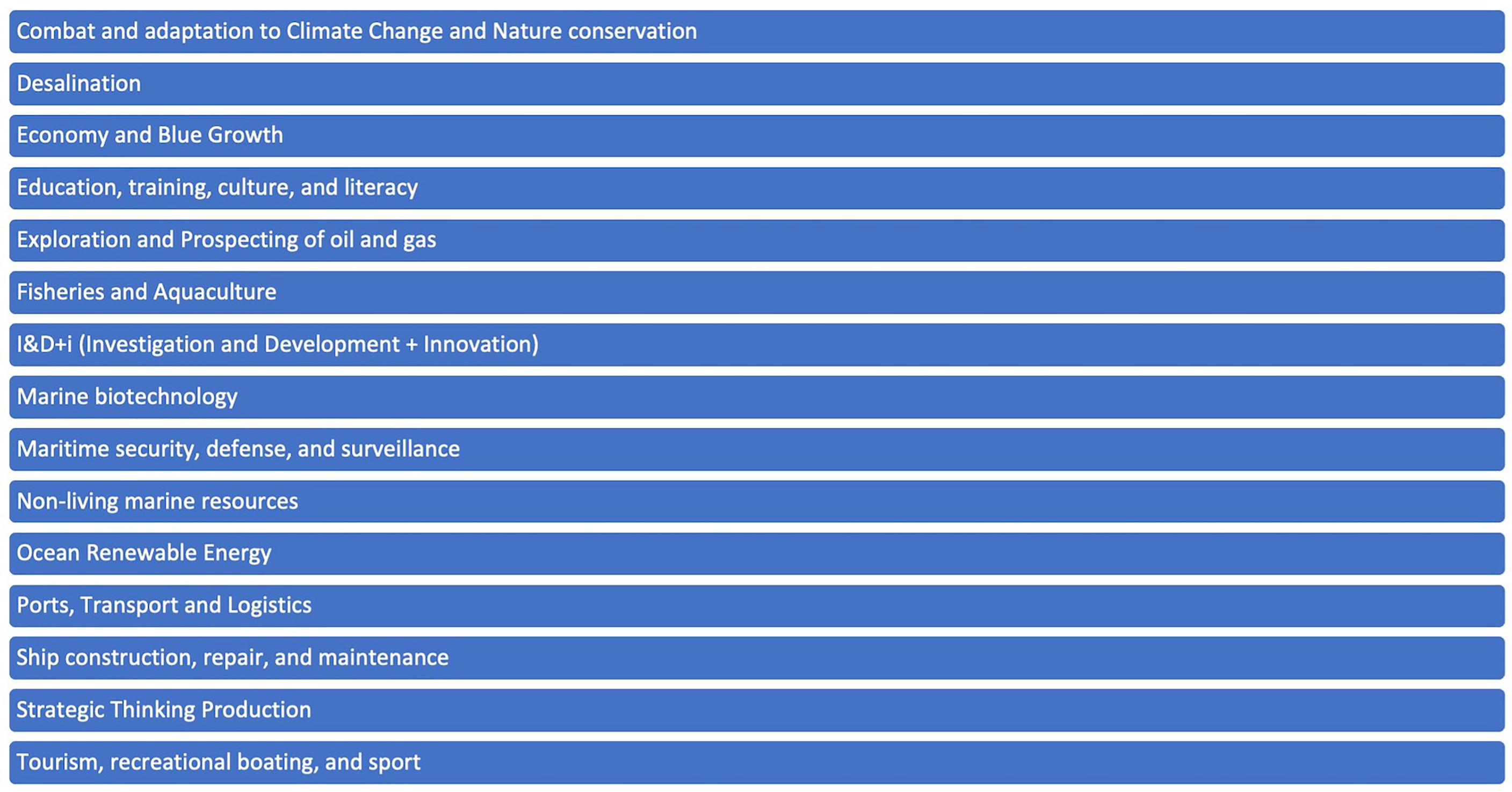
Figure 2 Most relevant socio-economic sectors in the context of the Atlantic Basin of the European Union. The socio-economic sectors identified belong to the Blue Growth and Blue Economy intervention areas. However, it was found that most of the countries under study have specific measures for both Blue Growth and Blue Economy, which are not included in the other socio-economic sectors. For this reason, and for this study, the socio-economic sector ‘Economy and Blue Growth’ was added.
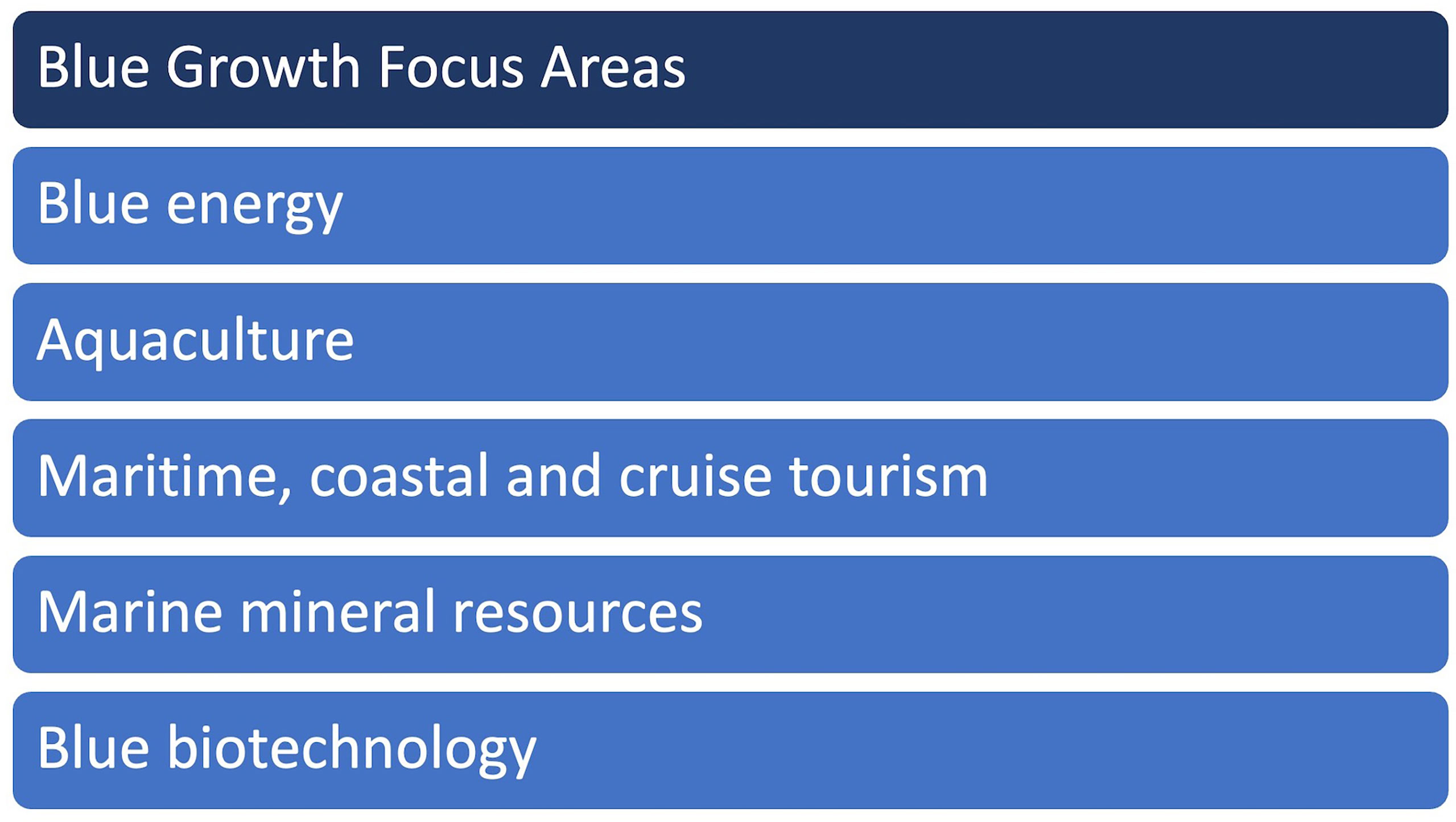
Figure 4 Blue Growth Strategy Focus Areas. The ‘Blue Economy’ was considered as the sixth Focus Area since most countries have specific measures for the Blue Economy in their National Ocean Strategies, which are not included in the Focus Areas of the Blue Growth Strategy. Source: Created by the author.
The National Ocean Strategy of France (Stratégie nationale pour la mer et le littoral), dates from 2019 identifies a total of 168 measures and objectives. In this strategy, the socioeconomic sector ‘Combating and adapting to climate change and nature conservation’, showed the highest number of measures. The ‘Desalination’ and ‘Oil and Gas Exploration and Prospecting’ sectors along with the ‘Non-living marine resources’ sectors were those that registered the fewest number of measures. Most socioeconomic sectors showed intermediate values between 15 and 25% (Figure 5).
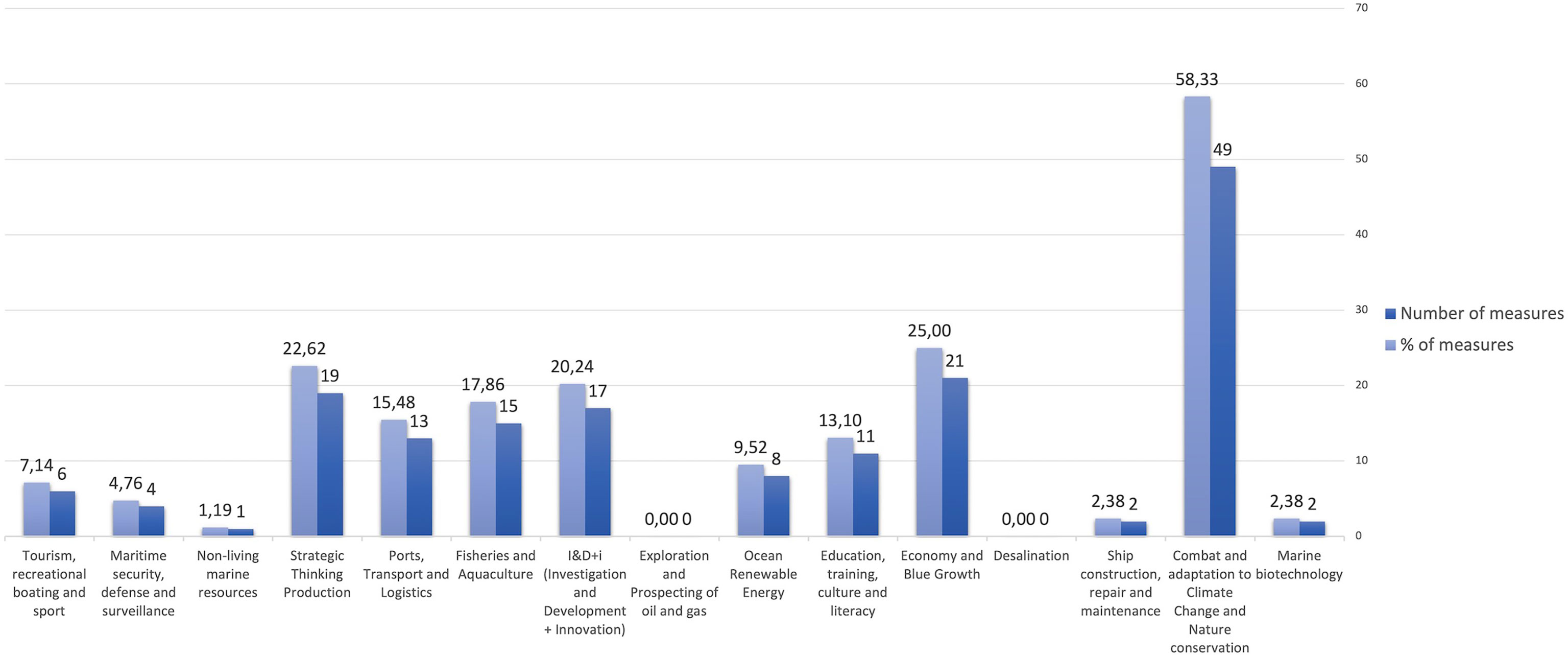
Figure 5 Number of identified measures, and corresponding percentage, by socio-economic sector, of France’s National Ocean Strategy. Source: Created by the author.
The “Harnessing our Ocean Wealth” is Ireland’s first Ocean Strategy dated from 2012, with a progress review report dated from 2015, on the 109 measures and goals. “3. The most prominent socio-economic sector was ‘Combat and Adaptation to Climate Change and Nature Conservation’, with 25 measures. On the other hand, for the socioeconomic sectors ‘Marine Biotechnology’, ‘Desalination’ and ‘Non-Living Marine Resources’ it wasn’t possible to find any kind of measures. The sectors ‘Naval construction, repair and maintenance’ and ‘Security, defense and maritime surveillance’ were the ones with the lowest number of measurements. Most of the socio-economic sectors with intermediate values showed percentages between 9% and 25%. For the remaining sectors, the percentage of measures did not exceed 6% (Figure 6).
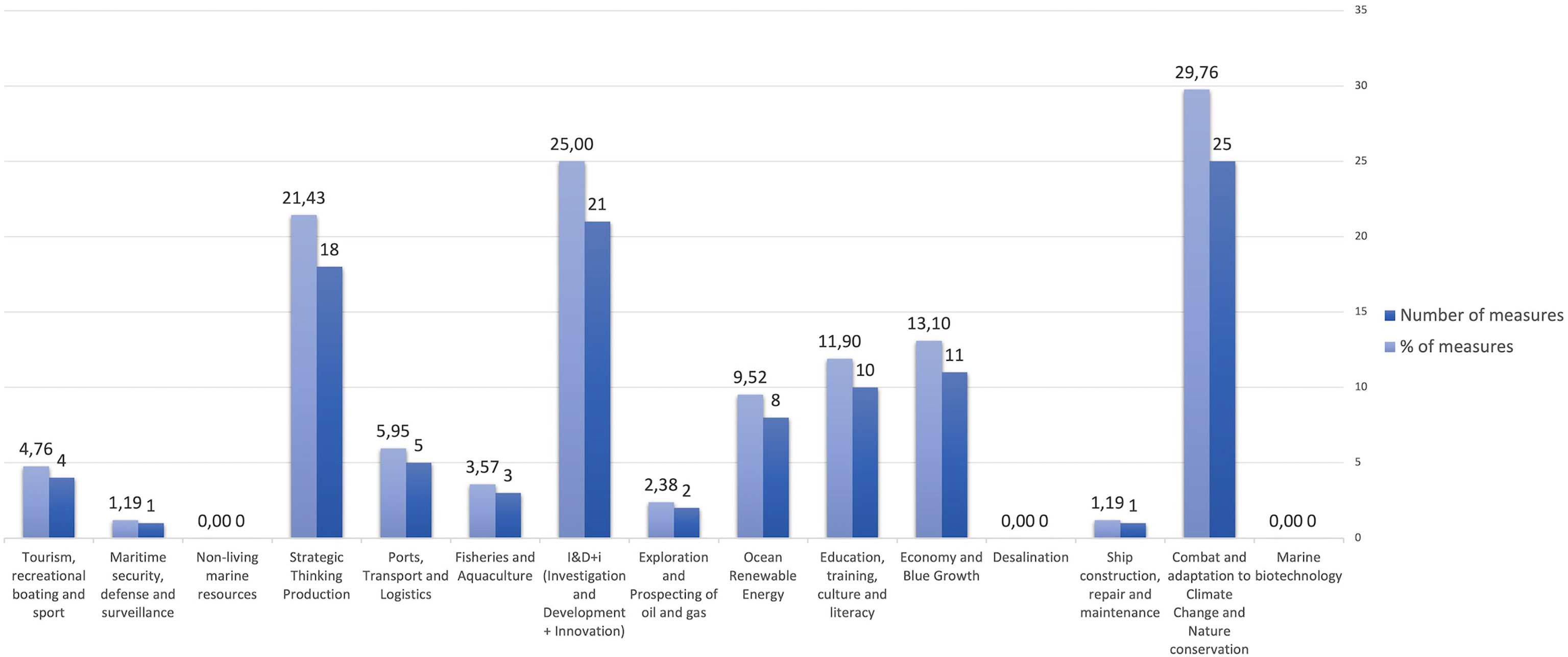
Figure 6 Number of identified measures, and corresponding percentage, by socio-economic sector, of Ireland’s National Ocean Strategy. Source: Created by the author.
The ‘Programa Operativo del FEMP 2014-2020’ from Spain is a plan designed to structure the funding received from the EU’s European Maritime and Fisheries Fund (2014-2020). All the case studies analyzed, have developed similar plans for this Fund. However, only the Spanish representative of the European group dedicated to the implementation of the European Union Strategy for the Atlantic answered in the questionnaire sent, that this plan is the equivalent of a National Ocean Strategy. In this plan, the socio-economic sector that registered the highest number of measures was ‘Fisheries and Aquaculture’. For the socio-economic sectors ‘Marine biotechnology’, ‘Ship construction, repair and maintenance’, ‘Desalination’, ‘Ocean Renewable Energy’, ‘Exploration and Prospecting of oil and gas’, ‘Ports, Transport and Logistics’, ‘Non-living marine resources’, and ‘Tourism, recreational boating, and sport’ it wasn’t possible to identify any kind of measures. The remaining values did not exceed 6% (Figure 7).
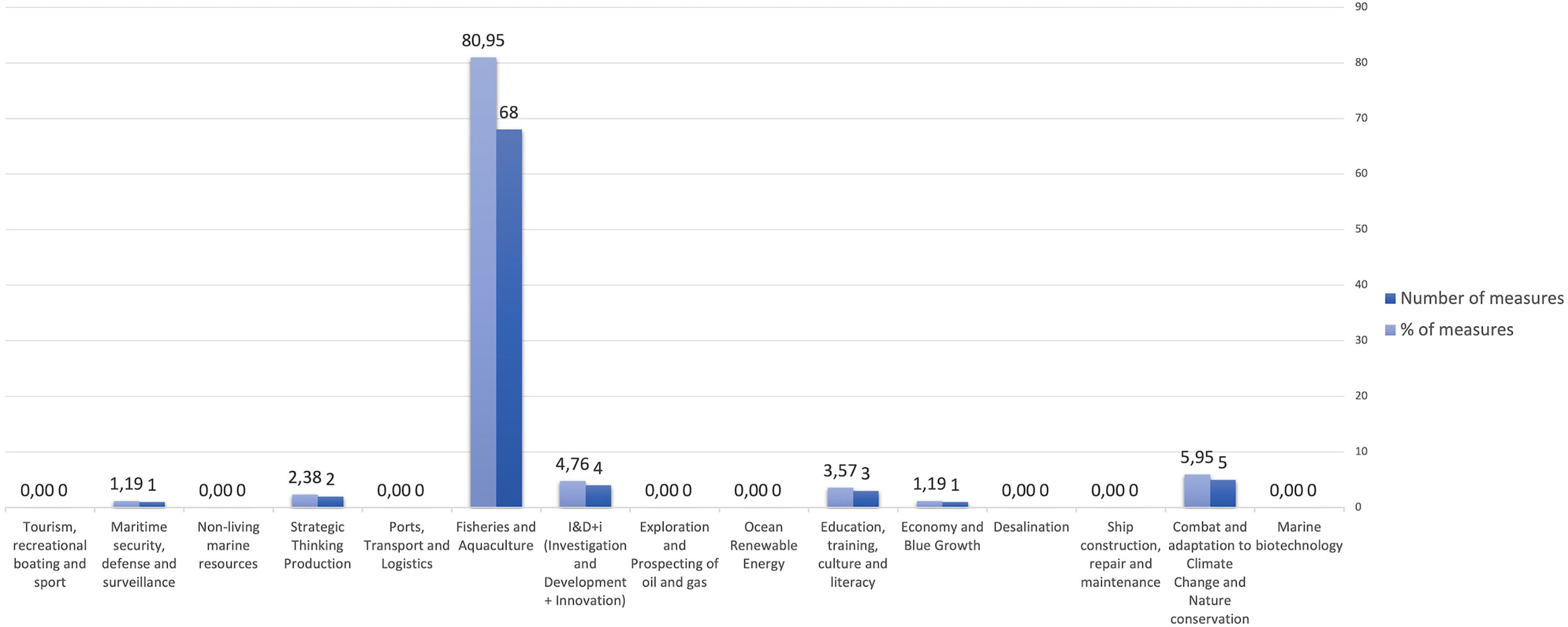
Figure 7 Number of identified measures, and corresponding percentage, by socio-economic sector, of Spain’s National Ocean Strategy. Source: Created by the author.
The “ENM 2021-2030” is the third Portugal’s National Ocean Strategy and its Action Plan identifies 185 measures and objectives. The socio-economic sector with the highest number of measures was ‘Education, training, culture, and literacy’. The socio-economic sector ‘Exploration and Prospecting of oil and gas’ didn’t show any measures and the sector ‘Desalination’ was the one with the lowest number. The other sector’s values were mostly between 17,86% and 33,33% (Figure 8).
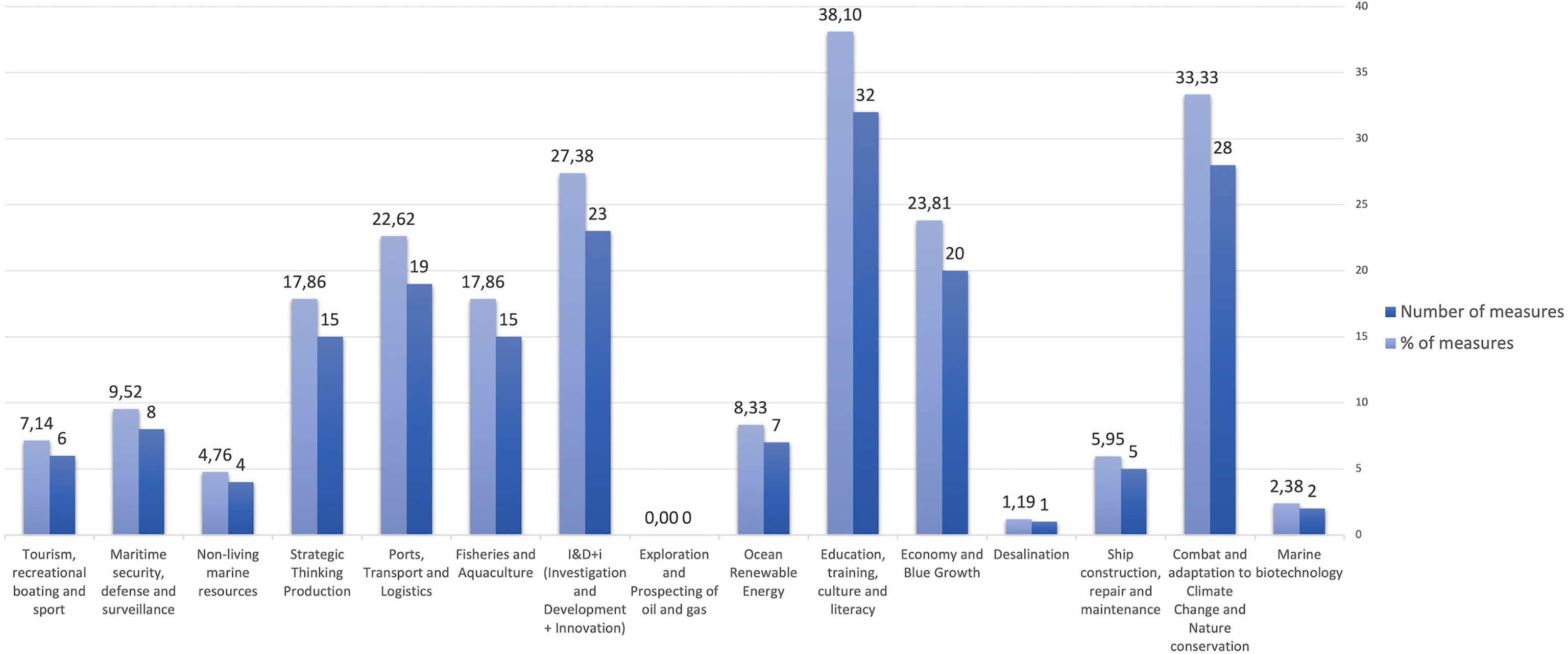
Figure 8 Number of identified measures, and corresponding percentage, by socio-economic sector, of Portugal’s National Ocean Strategy. Source: Created by the author.
In 2019 the UK implemented its Ocean Strategy through the “Maritime 2050 – Navigating the Future”. This strategy is composed of a total of 188 measures and objectives. The socio-economic sector with the highest number of measures was ‘Combat and adaptation to Climate Change and Nature Conservation’. On the contrary, the sector with the lowest number of measures was ‘Ocean Renewable Energy’. The sectors ‘Marine biotechnology’, ‘Desalination’, ‘Exploration and Prospecting of oil and gas’, ‘Fisheries and Aquaculture’, and ‘Non-living marine resources’ didn’t show any kind of measures. The other sector’s values were predominantly between 11,90% and 36,90% (Figure 9).
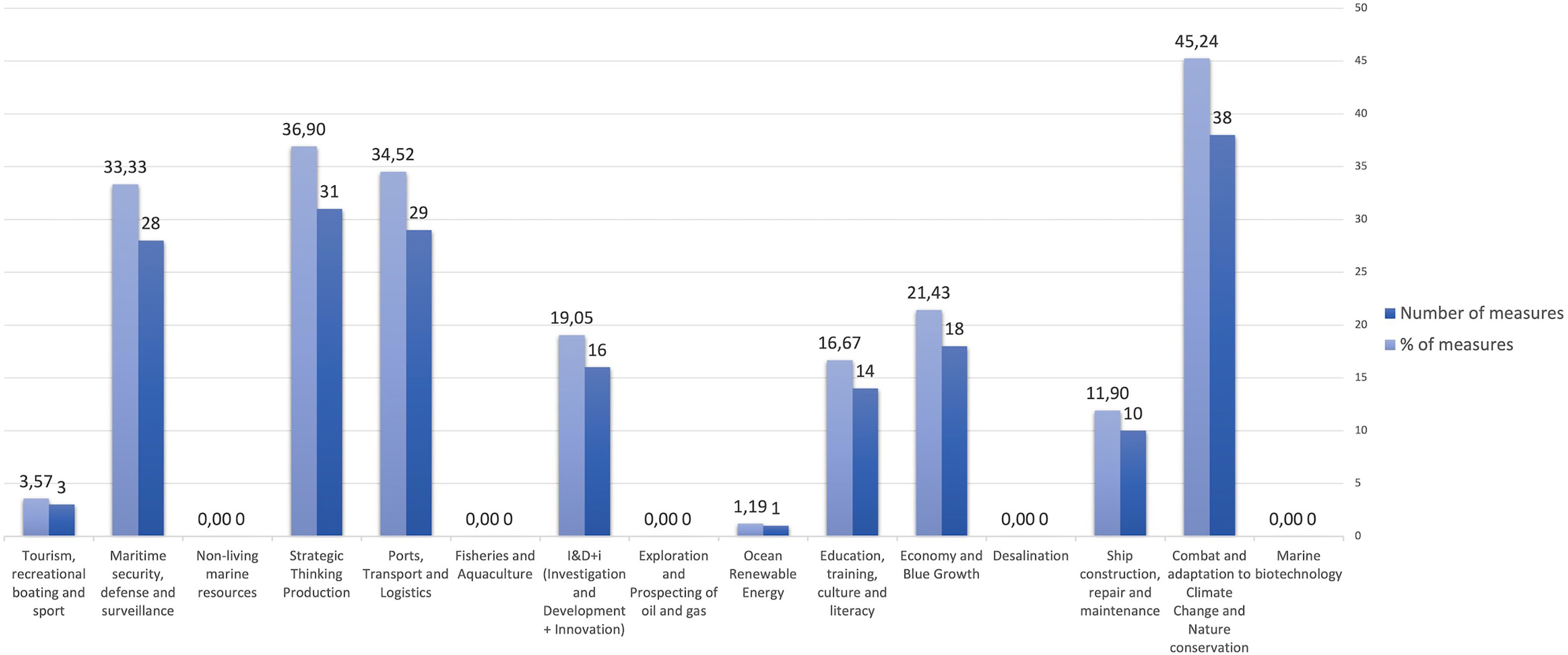
Figure 9 Number of identified measures, and corresponding percentage, by socio-economic sector, of UK’s National Ocean Strategy. Source: Created by the author.
The results obtained for the measures collected in the national ocean strategies, and expressed in the resultant figures, refer to absolute values and their corresponding percentages.
About 73,81% of the measures of the National Ocean Strategy of France are within the framework of the IMP. An example of two measures that stand out in terms of IMP, in the French strategy are “Regional cooperation between States bordering the same maritime area, as well as enhanced cross-border cooperation in regional seas, and in defining and implementing European and international policies” and “Tools for implementing spatial planning of maritime activities and uses must enable going beyond thematic approaches to optimize sustainable exploitation of the sea and the coast, and preservation of its biodiversity”. The Action Area with the highest percentage of measures was ‘Maximizing the sustainable use of the oceans and seas. ‘Raising the visibility of maritime Europe’ was the Action Area with the lower percentage (Figure 10).
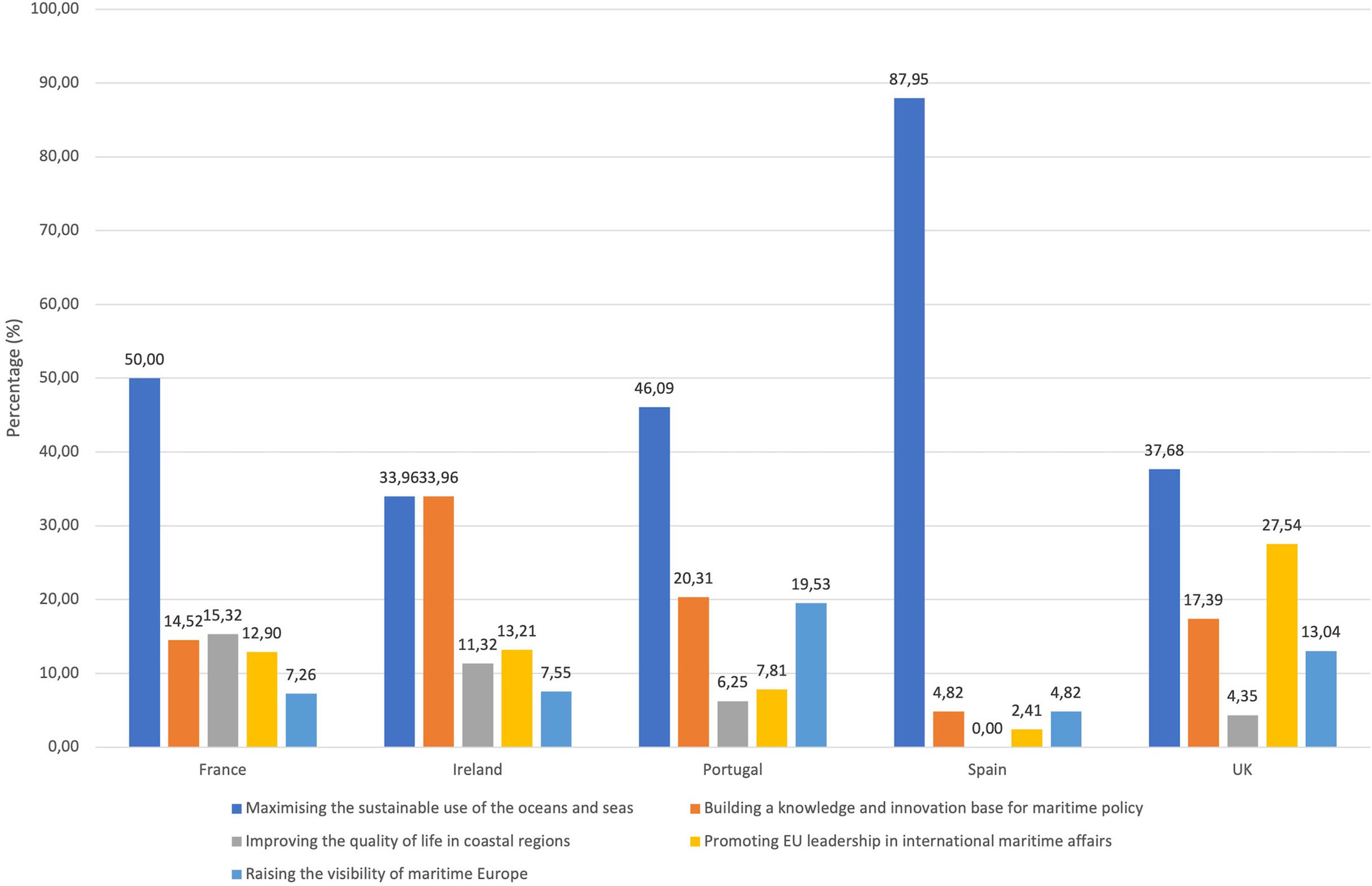
Figure 10 Percentage of measures of the five National Ocean Strategies analyzed within the framework of the IMP Action Areas. Source: Created by the author.
Ireland’s strategy showed a total of 48,62% of measures contributing to the implementation of the IMP. Two of the most prominent IMP measures in this strategy are “Develop an integrated approach to marine and coastal planning and licensing to maximize the potential for Ireland’s ocean economy; assist with managing our resources effectively and sustainably; manage potential conflicts; and ensure harmonization with coastal/terrestrial planning” and “Ensure the inclusion of marine research in all relevant Work Programmes developed under HORIZON 2020 to maximize EU marine research funding opportunities and support the implementation of IMP – EU and its Sea Basin Strategies”. The Action Areas where it was verified the highest percentage were ‘Maximizing the sustainable use of the oceans and seas’ and ‘Building a knowledge and innovation base for maritime policy’. On the contrary, the Action Area ‘Raising the visibility of maritime Europe’ exhibits the lowest percentage (Figure 10).
In Spain’s case, the percentage of measures that aid the accomplishment of the IMP was 98,81%. An example of one of these measures is “Assist in the design and implementation of conservation and cooperation measures”. The Action Area with the maximum percentage was ‘Maximizing the sustainable use of the oceans and seas’ and the minimum percentage was verified in the Action Area ‘Promoting EU leadership in international maritime affairs’. The percentage of the Action Area ‘Improving the quality of life in coastal regions’ was zero (Figure 10).
69,19% was the percentage obtained in the case of Portugal’s strategy. One of the most relevant measures of this strategy, regarding the IMP is “Ensure that the implementation of ENM 2021-2030, the national instrument of the EU Integrated Maritime Policy (IMP), is aligned with the implementation of the other instruments of the IMP (Common Information Sharing Environment), National Maritime Space Planning Situation Plan and DQEM, as an environmental pillar of the IMP)”.The Action Area that registered the highest percentage of measures was ‘Maximizing the sustainable use of the oceans and seas’. Opposingly, the Action Area ‘Improving the quality of life in coastal regions’ showed the lowest percentage of measures (Figure 10).
UK’s strategy had a percentage of 36,70% of measures that aimed at the implementation of the IMP. One of the main measures of this strategy, concerning the IMP is “Government will continue to support the rules-based international system to build and deepen our relationships with emerging global markets by strengthening alliances and building partnerships. We will encourage rational behavior by states and support the peaceful settlement of disputes”. Once more, the Action Area with the highest percentage of measures was ‘Maximizing the sustainable use of the oceans and seas’. ‘Improving the quality of life in coastal regions’ was the Action Area with the lowest percentage (Figure 10).
Tables 1, 2 summarize the information regarding the MSP and MSFD legislation for France, Ireland, Spain, Portugal, and the UK.
As mentioned earlier, the Blue Growth Strategy is constituted of five Focus Areas. However, when analyzing the selected national ocean strategies, it was found that some measures were too specific, not fitting into any of the five Focus Areas, and contributing equally to the Blue Economy. Therefore, there was the need to add a sixth Focus Area that included these measures, which was titled “blue economy”. The inclusion of the “blue economy” as a Focus Area does not in any way exclude the fact that the Focus Areas of the Blue Growth Strategy formally belong to the Blue Economy.
The percentage of measures of the National Ocean Strategy of France that are within the framework of the Focus Areas of the Blue Growth Strategy was 19,05%. In this strategy is possible to highlight two particular measures, regarding the Blue Growth Strategy: “Be the engine of European blue growth” and “With a view to blue growth and support for maritime employment at the European level, European programs will be used to promote the development of the French maritime sector via initiatives in maritime basins such as the Atlantic and the Mediterranean, or regional maritime policies in the overseas basins that have territories eligible for qualification as an extremely remote region”. The Focus Area with the highest percentage of measures was ‘Blue Energy’. Contrary, ‘Marine Mineral resources’ was the one with the lowest percentage. Most of the Focus Areas obtained percentages between 18% and 29% (Figure 11).
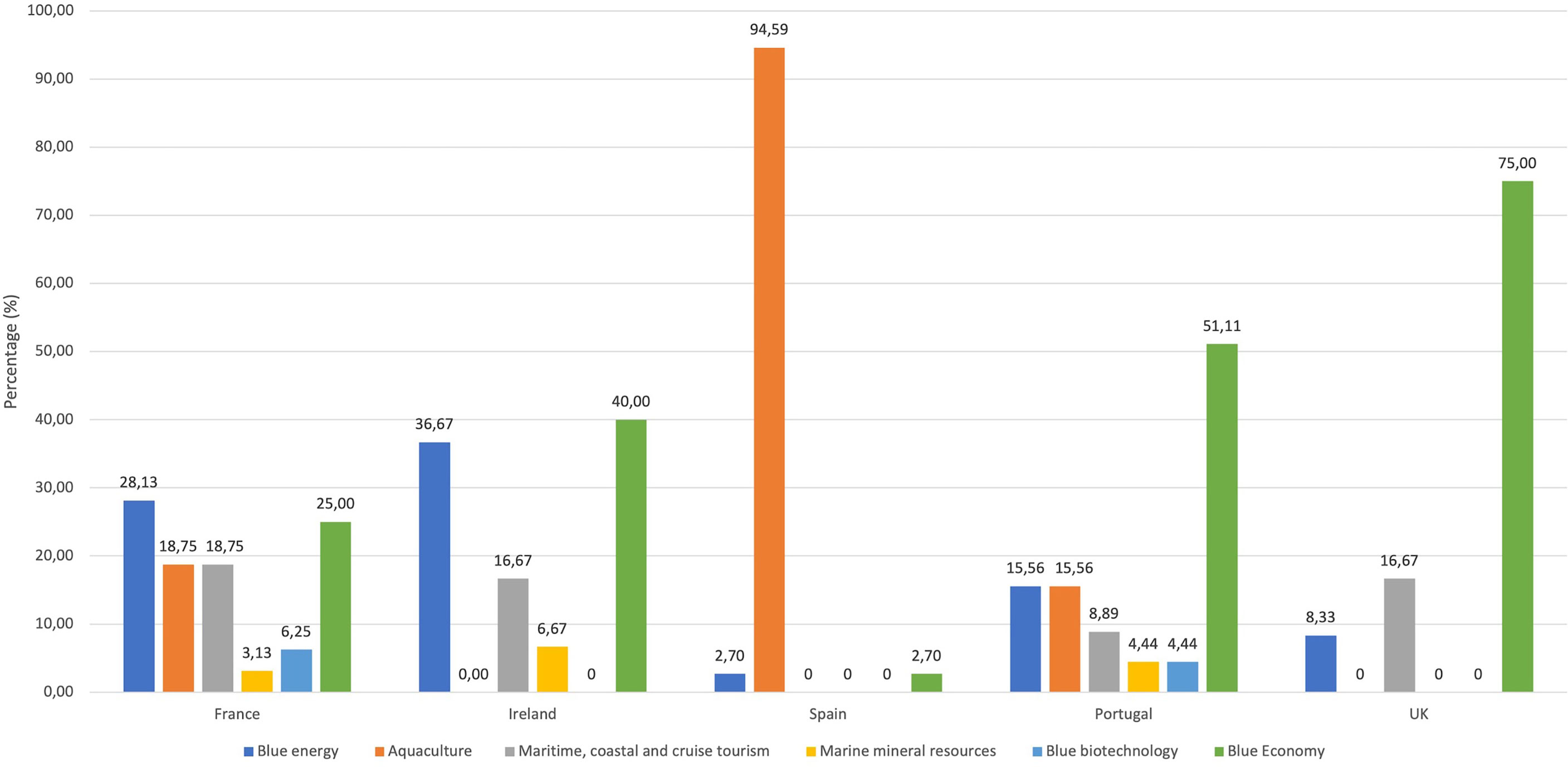
Figure 11 Percentage of measures of the five National Ocean Strategies analyzed within the framework of the Blue Growth Strategy Focus Areas. Source: Created by the author.
In Ireland’s case, 27,52% of the measures and objectives of the “Harnessing our Ocean Wealth” contribute to the implementation of the Blue Growth Strategy. One of the measures that emphasize the implementation of the Blue Growth Strategy is “Progress a number of targeted emerging business development opportunities (e.g. offshore renewables, offshore services, maritime security, and safety, shipping logistics and transport, ICT and sensors, biotechnology). This would include the collection/collation of market intelligence and foresight and the promotion of clusters using SmartOcean and IMERC as vehicles for innovation-led commercial development”. The Focus Area with the greatest number of measures obtained was ‘blue economy’ (40%). For the Focus Areas ‘Aquaculture’ and ‘Blue Biotechnology’ no measures were recorded. ‘Marine Mineral resources’ was the Focus Area with the smaller percentage (Figure 11).
For the case study of Spain, it was obtained a percentage of 44,05% of measures that have correspondence with the objectives of the Blue Growth Strategy. An example of one of these measures is “Preparatory assistance in promoting economic growth, social inclusion, job creation and support for employability and labor mobility in coastal and inland communities dependent on fisheries and aquaculture, including the diversification of activities carried out in the field of fisheries and with regard to others sea economy sectors”. ‘Aquaculture’ was the Focus Area with the maximum percentage of measures. However, for the Focus Areas ‘Maritime, coastal and cruise tourism’, ‘Marine mineral resources’ and ‘Blue biotechnology’ no measures were identified. The remaining Focus Areas got identical percentages (Figure 11).
Portugal’s strategy registered a total of 24,32% of measures within the scope of the Blue Growth Strategy and the ‘blue economy’ was the Focus Area with the greatest number of measures. ‘Marine mineral resources’ and ‘Blue biotechnology’ were the ones with the lowest percentage of measures (Figure 11). One of the measures of the Portuguese strategy that highlights the most, the effort to implement the blue growth strategy is “Develop a development cooperation strategy for the ocean and blue economy”.
The UK rate of measures contributing to the Blue Growth Strategy was only 6,38%, although the Focus Area ‘blue economy’ identified the highest number of measures. On the other hand, in the Focus Areas ‘Aquaculture’, ‘Marine mineral resources’ and ‘Blue biotechnology’ it wasn’t possible to recognize any kind of dedicated measures. ‘Blue Energy’ was the Focus Area with the smallest percentage (Figure 11). An example of a measure from the UK’s strategy that contributes to the implementation of the Blue Growth Strategy is “Government will work to better understand the capacity of the UK’s energy networks to support an increase in demand for green energy from our ports and shipping sectors. It will also consider the role the maritime and offshore renewables sectors can play in decentralized energy generation”.
The National Ocean Strategies of Ireland and Spain were the only ones where it wasn’t possible to identify correspondence of measures to all the selected SDGs. The strategy of Spain lacks measures for SDG 7 – Affordable and Clean Energy and SDG 17 – Partnerships for the goals. In Ireland’s case, it was SDG 2 – Zero Hunger the one with no match. In every case studied, the targets with the greatest number of measures belonged to SDG 14 – Life below water. Portugal’s strategy was the only one showing measures addressing all the targets, and consequently, all the SDGs (Figure 12).
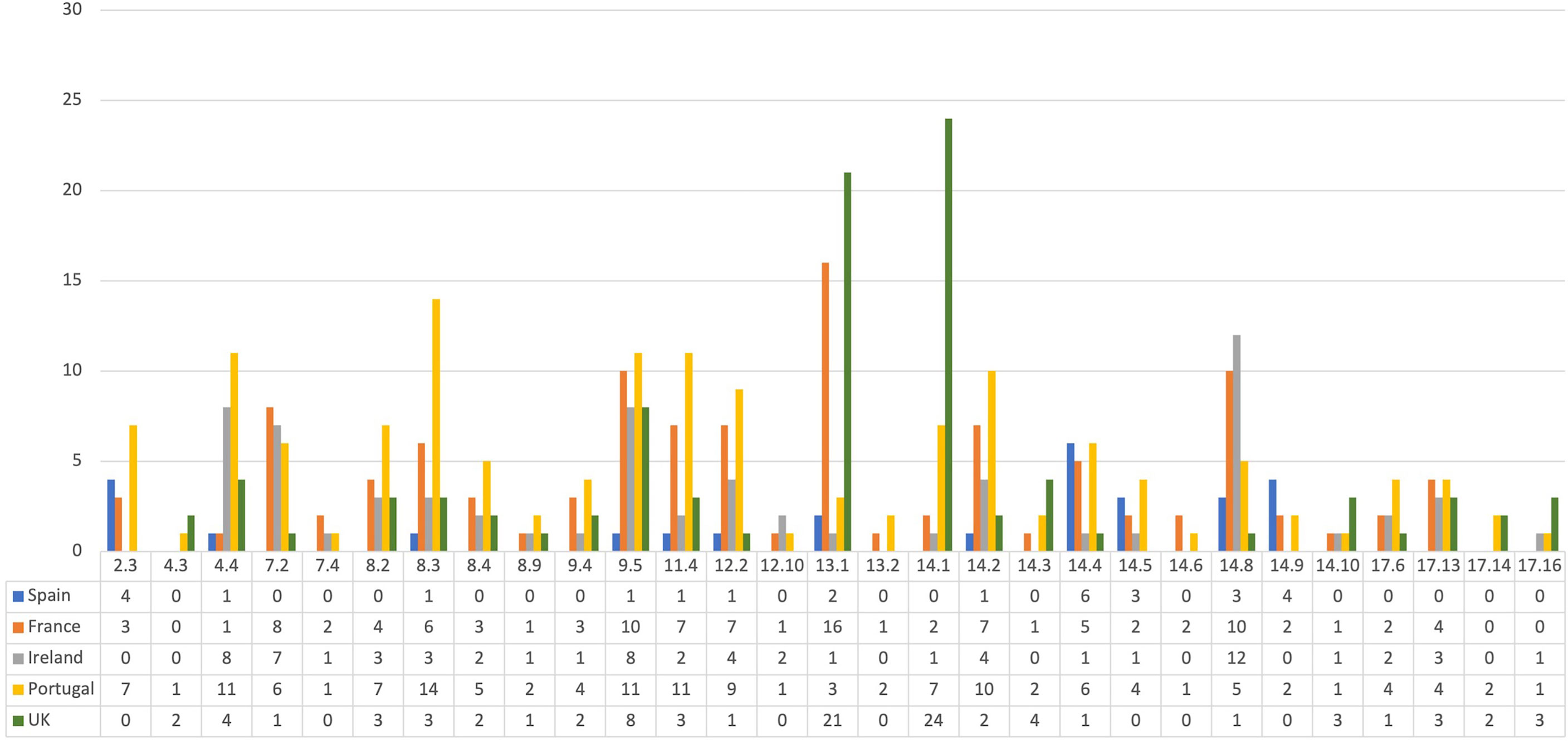
Figure 12 Number of measures by the target of the selected SDGs, for the five case studies. Source: Created by the author.
Regarding the United Nations Decade of Ocean Science for Sustainable Development, a total of 60,71% of measures of the National Ocean Strategy of France are within the framework of the Decade. ‘Develop a sustainable and equitable ocean economy’ was the Challenge with the maximum percentage of measures. Opposite the Challenge ‘Create a digital representation of the Ocean’ showed no measures. All the other Challenges had percentages between 2% and 17% (Figure 13).
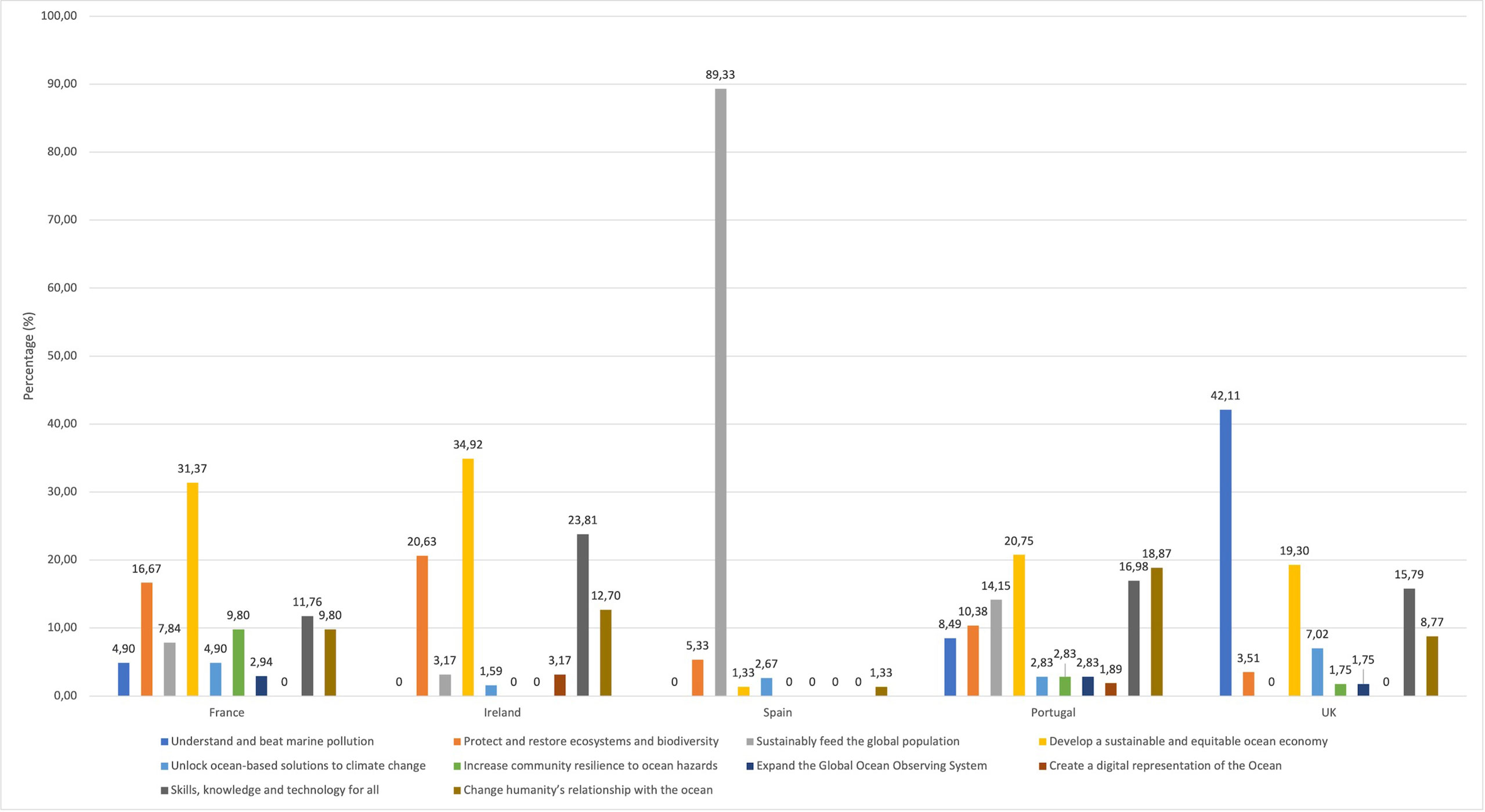
Figure 13 Percentage of measures of the five National Ocean Strategies analyzed according to the 10 key challenges of the United Nations Decade of Ocean Science for Sustainable Development. Source: Created by the author.
For Ireland, the percentage of measures concerning the objectives of the Ocean Decade are 57,80%, being ‘Develop a sustainable and equitable ocean economy’ the Challenge with the highest percentage of measures. Regarding the Challenges ‘Understand and beat marine pollution’, ‘Increase community resilience to ocean hazards’, and ‘Expand the Global Ocean Observing System’ no measures were identified. The remaining challenges did not exceed 24% (Figure 13).
Spain’s National Ocean Strategy had a percentage of 89,29% of measures contributing to the objectives of the Ocean Decade. However, only 5 of the 10 Challenges of the Decade showed related measures. The Challenge with the highest percentage of measures was ‘Sustainably feed the global population’. All the remaining Challenges obtain percentages below 5,33% (Figure 13).
Portugal’s strategy had a very similar percentage of measures contributing to the Ocean Decade to the Ireland Strategy, with 57,30%. Portugal was also the only case study that showed results matching all the 10 Challenges. The Challenge with the dominant number of measures was ‘Develop a sustainable and equitable ocean economy’ and the Challenge with the lowest number of measures was ‘Create a digital representation of the Ocean’ (Figure 13).
The UK case study showed the lowest percentage of measures contributing to the implementation of the Ocean Decade, with 30,32%. In this case, the Challenges ‘Sustainably feed the global population’ and ‘Create a digital representation of the Ocean’ didn’t show any measures. ‘Understand and beat marine pollution’ was the Challenge with the highest percentage and ‘Increase community resilience to ocean hazards’ and ‘Expand the Global Ocean Observing System’ were the ones with the smaller percentages (Figure 13).
The National Ocean Strategies of France, Portugal, and the UK were the only strategies that exhibited specific measures for the implementation of the SDGs, namely the SDG 14:
- “The strategy will contribute in particular to objective 14 of the sustainable development objectives” (France)
- “Monitor the results of the ENM 2021-2030 within the scope of the sustainable development goals (SDGs) of the United Nations 2030 Agenda, in particular at the level of SDG 14, ensuring their respective dissemination” (Portugal)
- “By 2030, in line with the UN Sustainable Development Goal 14, the UK will have supported the poorest and most vulnerable countries, in particular, Small Island Developing States (SIDS) and Least developed Countries (LDCs), to pursue wider benefits from growth in zero emission shipping, and will encourage other countries major economies to do likewise” (UK)
The ‘Programa Operativo del FEMP 2014-2020’ from Spain only contributes to one of the specific objectives of the four Priorities of the Atlantic Action Plan 2013-2020 – “Fostering adaptation and diversification of economic activities by promoting the potential of the Atlantic area”. For the Atlantic Action Plan 2.0, this strategy also contributes only to one Goal – “Quality education, training, and life-long learning”.
Four specific objectives of the Atlantic Action Plan 2013-2020 are lacking in Ireland’s National Ocean Strategy: “enhancement of competitiveness and innovation capacities in the maritime economy of the Atlantic area”, “fostering adaptation and diversification of economic activities by promoting the potential of the Atlantic area”, “sustainable management of marine resources” and “promoting cooperation between ports”. For the Atlantic Action Plan 2.0, the Goals 3 - Ports as gateways for trade in the Atlantic, 2- Ports as catalysts for business, and 5- Ports as catalysts for business are also missing.
The UK strategy misses six specific objectives of the Atlantic Action Plan 2013-2020: “enhancement of competitiveness and innovation capacities in the maritime economy of the Atlantic area”, “fostering adaptation and diversification of economic activities by promoting the potential of the Atlantic area”, “exploitation of the renewable energy potential of the Atlantic area’s marine and coastal environment”, “fostering better knowledge of social challenges in the Atlantic area” and “preserving and promoting the Atlantic’s cultural heritage”. On the other hand, regarding the Atlantic Action Plan 2.0, the measures identified in the National Ocean Strategy of the UK match all the Goals, apart from Goal 5 – “The promotion of carbon neutrality through marine renewable energy”.
France and Portugal are the only case studies where it was possible to identify measures that contribute to all the specific objectives of the Atlantic Action Plan 2013-2020 and all the Goals of the Atlantic Action Plan 2.0.
Results showed that there is a common guideline in the priorities of all the National Ocean Strategies analyzed as in most of the case studies, the socio-economic sector with the highest number of measures was ‘Combat and adaptation to Climate Change and Nature conservation’. In the case of Spain and Portugal’s strategies, this was the second socio-economic sector that registered the maximum number of measures, showing the political concerns on the severity of the effects of climate change in the Iberian Peninsula (Camargo et al., 2020). Several studies point to the Iberian Peninsula as one of the territories that will suffer a greater increase in temperatures due to the impact of climate change, until the end of the 21st century (Paniagua et al., 2019). This territory is also susceptible to reductions in precipitation, which can reach 10% in the southernmost regions, and to changes in the intensity of the near-surface wind (Pérez Cutillas, 2018; Martins et al., 2020; Pereira et al., 2021). The increase in temperatures together with the reduction in precipitation will lead to the decline of water stored in the soil, which will consequently impoverish the stability and permeability of soils, resulting in their desertification (Pérez Cutillas, 2018; García-Valdecasas Ojeda et al., 2020; Pereira et al., 2021). Both Spain and Portugal have made efforts to design and implement policies and actions to mitigate the consequences of climate change (Camargo et al., 2020). Spain was one of the first MS to create a plan for climate change. The National Climate Change Adaptation Plan (PNACC) was presented in 2006 and includes a list of impacts, vulnerabilities, and adaptation measures. This plan was updated four years after its first publication. The Spanish government can also count on the Spanish Strategy on Climate Change and Clean Energy published in 2007, which works together with the PNACC. In terms of mitigation, the existing Spanish legislation is mainly sectoral and is mostly derived from European directives (Escribano Francés et al., 2017; Camargo et al., 2020). Regarding climate change, Portugal published in 2015 the National Climate Change Program (PNAC 2020–2030), the National Strategy for Adaptation to Climate Change (ENAAC 2020), and the Interministerial Commission on Air and Climate Change (CIAAC). More recently, in 2019, the National Integrated Energy and Climate Plan (PNIEC) was published for the decade 2021-2030. This plan aims to promote energy efficiency, lead the number of renewable energy sources worldwide and promote equity among energy consumers (Camargo et al., 2020).
The ‘I&D+i (Investigation and Development + Innovation)’ was also a sector with several measures in each case study. On the contrary, for the ‘Desalination’ sector, measures were not recorded in all National Oceanic Strategies, except for Portugal’s strategy. The installation of seawater desalination plants in the southern region of Portugal is being discussed at a regional level, as a way of guaranteeing the water supply for the population, since this region is one of the most problematic areas in terms of water scarcity, in the world (Guerreiro et al., 2017; Neves et al., 2021). Apart from Ireland, the socio-economic sector ‘Exploration and Prospecting of oil and gas’ was the one with the lower number of measures. These results can be justified by the efforts that the EU has made, regarding combating climate change and reducing the emission of greenhouse gases, as well as the dissociation from fossil energies (Pereira, 2019). The EU has tried to replace fossil energy sources with renewable energy, with an increase from 9.6% to 18.9% of renewable energy from 2004 to 2018. In the transport sector, restrictions were also made on CO2 emissions from car fleets in 2009 (Haas and Sander, 2020). At a national level, MS developed National Energy and Climate Plans instructed and revised by the EC (Perissi and Jones, 2022). The Paris Agreement, adopted in 2015 at the Climate Conference in Paris, can also support the results obtained. This agreement was the first in the world dedicated exclusively to climate change, resulting in the EU’s target to reduce greenhouse gas emissions by 40% until 2030 (Soava et al., 2018). In addition to the Paris Agreement, the European Green Deal aims to achieve carbon neutrality by 2050, making Europe the first climate-neutral continent. This agreement aims to guide the establishment of new EU legislation that has as its main priority the reduction of carbon emissions (Eckert and Kovalevska, 2021).
The Spanish plan focuses mainly on fisheries and aquaculture, leaving aside essential maritime sectors for implementing the IMP, such as shipping. According to the EC (2008), “Shipping is vital for Europe’s international and domestic trade and remains the backbone of the maritime cluster”. Additionally, this plan doesn’t approach the socio-economic sectors of naval construction, repair, and maintenance, ocean renewable energy, oil and gas exploration and exploration, non-living marine resources and tourism, recreational boating, and sport, which are fundamental to IMP’s structure (EC, 2008). Although not part of the ‘Programa Operativo del FEMP 2014-2020’, some of the vital socio-economic sectors for the implementation of the IMP are distributed by different sectoral strategies, such as the “Plan Nacional Integrado de Energiía y Clima 2021-2030”, which is dedicated to climate change mitigation, renewable energy, and energy efficiency. However, despite the existence of distinct sectoral plans with measures and actions that contribute to the implementation of the IMP, Spain does not truly present a National Ocean Strategy in the context of the IMP, or even a national maritime policy (Quero García et al., 2021). There is a dispersion of measures between sectoral plans that is not in line with the recommendations of the IMP for an integrated approach. Consequently, Spain didn’t fulfill the request of the EC for the MS for the elaboration of integrated national maritime policies (Becker-Weinberg, 2015). Although most of the objectives and measures of the ‘Programa Operativo del FEMP 2014-2020’ contribute to the framework of the Blue Growth Strategy and the IMP, this plan leaves out half of the Focus Areas of the Blue Growth Strategy and the Action Area of the IMP ‘Improving’ the quality of life in coastal regions’. This Action Area is of extreme importance for the implementation of IMP because “The first goal of an EU Integrated Maritime Policy is to create optimal conditions for the sustainable use of the oceans and seas, enabling the growth of maritime sectors and coastal regions” (EC, 2007). Spain’s lack of alignment with the IMP is reinforced by the fact that it has not yet completed the development of its MSP plans (Quero García et al., 2021).
Identical to Spain’s strategy, the UK’s ‘Maritime 2050’ cannot also be considered as a National Ocean Strategy in the IMP framework. This strategy is dedicated to maritime transportation, and the social-economic sector ‘Fisheries and Aquaculture ‘is missing. This sector is critical to the implementation of IMP. According to the EC (2007) it’s necessary “to eliminate Illegal, Unreported and Unregulated fishing in its waters and on the high seas (…), the improvement of on-the-job safety of fishermen must also be addressed in the wider context of maritime working conditions and social policy (…), and the growth of aquaculture to satisfy increasing global seafood demand should be achieved within a regulatory framework that encourages entrepreneurship and innovation and ensures compliance with high environmental and public health standards”. This strategy does not identify measures for any of these recommendations. Additionally, the UK’s strategy doesn’t display measures for half of the Focus Areas of the Blue Growth Strategy and, as Spain’s strategy, has a very small number of measures for the IMP Action Area ‘‘Improving’ the quality of life in coastal regions’. Like Spain, the UK has a variety of sectoral plans dedicated to socio-economic sectors that are not included in the “Maritime 2050 – Navigating the Future”. The “Fisheries Act 2020” regulates the sustainable management of fisheries, aquaculture, and marine conservation. The “Growing the bioeconomy: a national bioeconomy strategy to 2030” aims to transform the UK’s economy using biological sciences and biotechnology. These two sectoral plans were not introduced in this study, since only the strategies indicated in the responses to the questionnaires were analyzed.
Ireland’s Nation Ocean Strategy is, of all documents analyzed in the case studies, the oldest strategy. Despite being considered a Nation Ocean Strategy in the context of the IMP and contributing to the implementation of the IMP Action Areas, it is outdated when compared to the strategies of France and Portugal, not responding to some of the Focus Areas of the Blue Growth Strategy. The lack of measures for the ‘Aquaculture’ and ‘Blue Biotechnology’ Focus Areas can be justified by the date of publication of the ‘Harnessing our Ocean Wealth’. This strategy was officially published on July 1, 2012, before the release date of the “Communication from the Commission to the European Parliament, the Council, the European Economic and Social Committee and the Committee of the Regions: Blue Growth - opportunities for marine and maritime sustainable growth”. Therefore, the Irish strategy was written before the final publication of the Blue Growth Strategy, and for this reason, it may not exhibit measures and actions that fall within all the Focus Areas that contribute to the implementation of the Blue Growth Strategy. The lowest number of measures in some social-economic sectors of Ireland’s strategy can also be justified by the existence of distinguished sectorial plans. It’s the case of the “Marine Biotechnology Task Force Report”, which is dedicated to enhancing the use of marine bioresources, the “National Strategic Plan for Sustainable Aquaculture Development” and the “Statement of Strategy 2018-2020. Enabling Sustainable Growth”, both dedicated to fisheries and aquaculture, and the “Irish Maritime Directorate Strategy 2021-2015” which sets out the main objectives for the Irish maritime transportation sector. These sectoral plans weren’t analyzed because, for this study, only the strategies presented in the answered questionnaires were considered.
Of all the case strategies studied, the National Ocean Strategies of France and Portugal are those that are truly in line with the EU IMP. The strategies of these two countries incorporate all the objectives and action fields of this policy, as well as the socio-economic sectors most relevant to it, complying with the EC’s request for the development of integrated national maritime policies. These two maritime strategies also include all the Focus Areas of the Blue Growth Strategy, one of the main pillars of the IMP. In terms of legislation, these case studies incorporated the MSP and the MSFD at a national level, as requested by the EC. Both these countries have a historical relationship with the Sea, specifically with the south of the Atlantic. They are also the two EU MS with the highest EEZ (Guerreiro, 2021; Guerreiro et al., 2021; Santos, 2021). France has a long history of land spatial planning, particularly with coastal management. The French government has increasingly recognized the importance of maritime policies, which lead to the creation of the Ministry for the Sea, in 2020. The main objective of this ministry is to promote Blue Growth and develop policies related to the oceans and MSP (Guerreiro et al., 2017; Guerreiro, 2021). Portugal was one of the first EU countries to develop a national ocean strategy, in 2006. However, its relationship with ocean policies dates to the 90s with the World Ocean International exhibition in 1998 (EXPO98). In governmental terms, the importance of creating a ministry specialized in Sea affairs was recognized with the Ministry of Economy and the Sea. Two other institutions specializing in maritime policies were also introduced, the General Directorate for Maritime Policy and the General Directorate of Natural Resources, Security, and Maritime Services. The first is responsible for creating and managing national ocean strategies and issues related to Blue Growth. The second specializes in the implementation of MSP and MSFD, the environmental pillar of the IMP (Guerreiro, 2021; Guerreiro et al., 2021; Santos, 2021).
Regarding the framework of the SDGs and Decade of Ocean Sciences for Sustainable Development in the National Ocean Strategies, Spain and Ireland were the only countries whose strategies did not fit all the selected SDGs. The National Ocean Strategies of the remaining countries are aligned with the SDGs, exhibiting measures exclusively dedicated to their achievement. In all case studies, it was clear that the Ocean Strategies display a greater number of measures for the goals of SDG 14 – Life Below Water. In general, all the National Ocean Strategies of the case studies contribute to the implementation of the Decade of Ocean Sciences for Sustainable Development, apart from Spain’s strategy, which does not respond to half of the Decade’s key challenges. Portugal’s National Ocean Strategy was the only strategy that presented measures for all the targets of the selected SDGs, as well as for all the key challenges of the Decade of Ocean Sciences for Sustainable Development. For this reason, it can be considered the National Ocean Strategy that contributes most efficiently to the implementation of the 2030 Agenda. Nevertheless, considering additionally sectorial policies all the case studies have additional measures aligned with several SDGs of the 2030 Agenda.
The studied countries are part of the European Union Strategy for the Atlantic Area, sharing economic, social, and environmental characteristics4. Therefore, it would be expected common management of maritime activities and convergence of the socio-economic sectors of their National Ocean Strategies (EC, 2011). The importance of ‘Combat and adaptation to Climate Change and Nature conservation’ is one of the characteristics that all the analyzed national ocean strategies have in common. This feature is in line with one of the most important areas of action of the new EU’s Atlantic Action Plan 2.0, the protection of the environment, with special emphasis on coastal areas (Aguiar Machado, 2019). The EC acknowledged that there was a data gap for a precise socio-economic analysis to be carried out, in the Atlantic region. For this reason, it requested the ME belonging to the EU Strategy for the Atlantic Area to collect the best accurate data. Except for Spain, all the strategies analyzed offered a reasonable number of measures for the ‘I&D+i (Investigation and Development + Innovation)’ sector, which meets the EC’s request (Fernández-Macho et al., 2015). Spain is, of all the case studies, the country that is least integrated into the EU’s Atlantic Arc, which is verified by the fact that it does not present a national maritime policy and a national ocean strategy in the context of the IMP framework (Fernández-Macho et al., 2015; Quero García et al., 2021). The Spanish strategy was the one that least incorporated the objectives of both Atlantic Action Plan 2013-2020 and Atlantic Action Plan 2.0. That can be justified by the fact that the ‘Programa Operativo del FEMP 2014-2020’ is mostly dedicated to the sectors of fisheries and aquaculture. The UK’s ‘Maritime 2050’ is a strategy predominantly focused on maritime transportation. Although it contains measures and actions that contribute to the achievement of most of the objectives of the Atlantic Action Plan 2.0, it leaves out essential areas for the sustainable development of the region covered by this plan, such as aquaculture, fisheries, and marine renewable energy sectors (EC, 2011). The two action plans for the EU’s Atlantic Area are amongst the most developed within all the EU Ocean Basins action plans. One of the main principles of both Atlantic action plans is the achievement of Blue Growth (Dalton et al., 2019). Yet, Ireland’s national ocean strategy does not exhibit measures that contribute to the realization of two Focus Areas of the Blue Growth Strategy. Ireland is also the case study with the most outdated National Ocean Strategy, as it was published in 2012. For this reason, it would be expected that this strategy would better fit the objectives of the first version of the Atlantic Action Plan. However, four of the ten specific objectives of this plan are not addressed by the measures and actions of ‘Harnessing our Ocean Wealth’. For the Atlantic 2.0 Action Plan, Ireland’s maritime strategy misses two of this plan’s seven key objectives. France and Portugal are the only members of the EU Strategy for the Atlantic Area that truly incorporate the objectives of both Atlantic Action Plans in their National Ocean Strategies. The national ocean strategies of these two countries display specific measures for the fulfillment of the EU Strategy for the Atlantic Area. There is also conformity in the socio-economic sectors of both maritime strategies. Both these countries have a historical interest in the Atlantic area, recognizing the importance of creating measures for the proper management of the Atlantic Ocean (Guerreiro, 2021).
The EU’s Atlantic area possesses unique characteristics and acts as a development motor for its MS. For the maximization of the sustainable growth of this area, it is expected that its countries, develop policies and manage their maritime activities in a coordinated way (EC, 2011). This study shows that most of the countries analyzed have similar key priorities. The combat and adaptation to climate change and nature conservation was the main key priority for all the national ocean strategies examined, together with the I&D+I (Investigation and Development + Innovation). On the other hand, in all strategies, there are few measures for the exploration and prospecting of oil and gas, in line with EU Green Deal (EC, 2019).
It also became clear that Spain is the country further behind the adoption of IMP’s objectives and guidelines. Spain has not yet completed the development of its MSP plans and its national ocean strategy leaves out half of the Blue Growth Strategy Focus Areas. The Spanish maritime strategy cannot also be considered a national ocean strategy according to the IMP framework because it leaves out essential sectors for the implementation of the IMP, which can be found in distinctive sectoral plans. Thus, Spain does not comply with the EC recommendation for the creation of an integrated national maritime policy (Becker-Weinberg, 2015). The same applies to the UK’s maritime strategy. Although several reasons can be pointed out for the inexistence of a real IMP in Spain it cannot be discarded that the autonomic nature of the Spanish state makes it harder to develop real national integrated policies (Tudela Aranda, 2013). Ireland’s national ocean strategy is clearly outdated when compared to the strategies of France and Portugal. The modernization of this strategy would be favorable for a better implementation of the IMP and of one of its main pillars, the Blue Growth Strategy. On the contrary, France and Portugal lead the way in implementing IMP, and their national ocean strategies undoubtedly demonstrate this.
Regarding the SDGs, it is unequivocal that SDG 14 – Life Bellow Water is the one that stands out in all national ocean strategies. On the other hand, only the Spanish and Irish strategies were the ones that did not contribute to the implementation of all the selected SDGs in an integrated way. Furthermore, the Spanish strategy also is the one that that least follows the key challenges of the Decade of Ocean Sciences for Sustainable Development. By contrast, the Portuguese strategy is the one that contributes the most to the accomplishment of the selected SDGs, as well as the Decade of Ocean Sciences for Sustainable Development.
The selected countries approach the EU Strategy for the Atlantic Area and its Action Plan in different ways. Spain’s strategy is dedicated to aquaculture and fisheries, being the strategy that least fits the Atlantic Action Plan 2.0. The focus of the UK maritime strategy is maritime transportation. Although the objectives of this strategy correspond to some of the objectives of the Atlantic Action Plan 2.0, it leaves behind essential areas for the sustainable development of this region, such as ocean renewable energy and marine biotechnology. France and Portugal are, once again, the countries that truthfully contribute to the realization of the EU’s Strategy for the Atlantic Area. The maritime strategies of these two countries are aligned with the objectives of the old and new Atlantic Action Plan, incorporating specific measures for the fulfillment of this EU Basin Strategy.
The sustainable development of the EU’s Atlantic Area is categorically dependent on the holistic and integrated management of the countries that comprise it. Therefore, the establishment of integrated national ocean strategies will be fundamental for the growth of this region. The national ocean strategies of France and Portugal can pave the way for a new generation of maritime strategies, serving as an example for other countries and are at the moment leading the maritime policies in this region which no doubt represents the political priority given by the French and Portuguese governments to ocean policies, also reflecting the relevance of their EEZ’s at a global scale.
The results obtained with this study can also contribute as a starting point for the creation of a working group that could allow a better alignment between the national ocean strategies of the countries of the Atlantic basin of the EU. It could follow the example of the HELCOM-VASAB MSP, adopted for the Baltic Sea region. This working group’s ambition is to facilitate the integration of EU Directives with national planning policies (Hassler et al., 2018). The creation of a structure like the HELCOM-VASAB MSP, for the EU Atlantic basin, could thus ensure that the countries belonging to it, could work together as a network, for a more prosperous and successful implementation of the EU IMP and the Atlantic Action Plan 2.0.
The original contributions presented in the study are included in the article/supplementary material. Further inquiries can be directed to the corresponding author.
Ethical review and approval was not required for the study on human participants in accordance with the local legislation and institutional requirements. The patients/participants provided their written informed consent to participate in this study.
ISM: Initial research design, Data collection, Conceptualization, Methodology, Investigation, Writing - original draft. JG: Conceptualization, Validation, Formal analysis, Resources, Writing - review and editing, Supervision, Project administration. CS: Conceptualization, Validation, Formal analysis, Resources, Writing - review and editing. All authors contributed to the article and approved the submitted version.
This publication was financed by the European Union’s Horizon 2020 Research and Innovation Programme under grant agreement N810139: Project Portugal Twinning for Innovation and Excellence in Marine Science and Earth Observation – PORTWIMS.
ISM acknowledges DGPM for all the support provided.
The authors declare that the research was conducted in the absence of any commercial or financial relationships that could be construed as a potential conflict of interest.
All claims expressed in this article are solely those of the authors and do not necessarily represent those of their affiliated organizations, or those of the publisher, the editors and the reviewers. Any product that may be evaluated in this article, or claim that may be made by its manufacturer, is not guaranteed or endorsed by the publisher.
Aguiar Machado J. (2019). “Challenges and opportunities for blue growth in Atlantic regions and cities,” in City policies and the European urban agenda. Eds. Martín L.F-P, Castro D (London, UK: Springer International Publishing), 109–140. doi: 10.1007/978-3-030-10847-2_4
Becker-Weinberg V. (2015). Portugal’s legal regime on marine spatial planning and management of the national maritime space. Marine Policy. 61, 46–53. doi: 10.1016/j.marpol.2015.06.014
Calado H., Papaioannou E. A., Caña-Varona M., Onyango V., Zaucha J., Przedrzymirska J., et al. (2019). Multi-uses in the Eastern Atlantic: Building bridges in maritime space. Ocean Coast. Manage. 174, 131–143. doi: 10.1016/j.ocecoaman.2019.03.004
Camargo J., Barcena I., Soares P. M., Schmidt L., Andaluz J. (2020). Mind the climate policy gaps: climate change public policy and reality in Portugal, Spain, and Morocco. Climatic Change 161 (1), 151–169. doi: 10.1007/s10584-019-02646-9
Chintoan-Uta C. (2014). The successes and failures of the European union integrated maritime policy: Critical mid-term review. J. Contemp. Eur. Res. 10 (3), 355–365. doi: 10.30950/jcer.v10i3.610
Dalton G., Bardócz T., Blanch M., Campbell D., Johnson K., Lawrence G, et al (2019). Feasibility of investment in Blue Growth multiple-use of space and multi-use platform projects; results of a novel assessment approach and case studies. Renewable and Sustainable Energy Rev. 107, 338–359. doi: 10.1016/j.rser.2019.01.060
EC (2006) Green Paper. Towards a future Maritime Policy for the Union: a European vision for the oceans and seas. (COM, (2006) 275 final. Volume II - Annex). Available at: https://eur-lex.europa.eu/resource.html?uri=cellar:b2e1b06a-6ca9-4e24-ac15-60e1307f32e2.0006.03/DOC_1&format=PDF (Accessed May 5, 2022).
EC (2007) Communication from the Commission to the European Parliament, the Council, the European Economic and Social Committee, and the Committee of the Regions - An Integrated Maritime Policy for the European Union (COM, (2007) 575 final). Available at: https://eur-lex.europa.eu/legal-content/EN/TXT/?uri=CELEX%3A52007DC0575 (Accessed May 5, 2022).
EC (2008) Communication from the commission. roadmap for maritime spatial planning: Achieving common principles in the EU (COM(2008) 791 final). Available at: https://eur-lex.europa.eu/LexUriServ/LexUriServ.do?uri=COM:2008:0791:FIN:EN:PDF (Accessed May 5, 2022).
EC (2009) Report from the commission to the council, the European parliament, the European economic and social committee and the committee of the regions. progress report on the EU's integrated maritime policy (COM(2009)540 final). Available at: https://eur-lex.europa.eu/LexUriServ/LexUriServ.do?uri=COM:2009:0540:FIN:EN:PDF (Accessed May 5, 2022).
EC (2011) Communication from the commission to the European parliament, the council, the European economic and social committee and the committee of the regions - developing a maritime strategy for the Atlantic ocean area (COM(2011) 0782 final). Available at: https://eur-lex.europa.eu/legal-content/EN/ALL/?uri=CELEX%3A52011DC0782 (Accessed May 5, 2022).
EC (2012) Communication from the commission to the European parliament, the council, the European economic and social committee and the committee of the regions - blue growth opportunities for marine and maritime sustainable growth (COM(2012) 494 final). Available at: https://eur-lex.europa.eu/legal-content/EN/ALL/?uri=CELEX%3A52012DC0494 (Accessed May 5, 2022).
EC (2013) Communication from the commission to the European parliament, the council, the European economic and social committee and the committee of the regions - action plan for a maritime strategy in the Atlantic area delivering smart, sustainable and inclusive growth (COM(2013) 279 final). Available at: https://eur-lex.europa.eu/legal-content/EN/TXT/PDF/?uri=CELEX:52013DC0279&from=EN (Accessed May 5, 2022).
EC (2019) Communication from the commission. the European green deal (COM(2019) 640 final). Available at: https://eur-lex.europa.eu/legal-content/EN/TXT/?qid=1576150542719&uri=COM%3A2019%3A640%3AFIN (Accessed May 5, 2022).
EC (2020) Communication from the commission to the European parliament, the council, the European economic and social committee and the committee of the regions - a new approach to the Atlantic maritime strategy – Atlantic action plan 2.0 - an updated action plan for a sustainable, resilient and competitive blue economy in the European union Atlantic area (COM(2020) 329 final). Available at: https://eur-lex.europa.eu/legal-content/EN/TXT/PDF/?uri=CELEX:52020DC0329&from=EN (Accessed May 5, 2022).
Eckert E., Kovalevska O. (2021). Sustainability in the European union: Analyzing the discourse of the European green deal. J. Risk Financial Manage. 14 (2), 80. doi: 10.3390/jrfm14020080
Escribano Francés G., Quevauviller P., San Martín González E., Vargas Amelin E. (2017). Climate change policy and water resources in the EU and spain. a closer look into the water framework directive. Environ. Sci. Policy 69, 1–12. doi: 10.1016/j.envsci.2016.12.006
Fernández-Macho J., Murillas A., Ansuategi A., Escapa M., Gallastegui C., González P., et al. (2015). Measuring the maritime economy: Spain in the European Atlantic arc. Mar. Policy 60, 49–61. doi: 10.1016/j.marpol.2015.05.010
Foley N. S., Corless R., Escapa M., Fahy F., Fernandez-Macho J., Gabriel S., et al. (2014). Developing a comparative marine socio-economic framework for the European Atlantic area. J. Ocean Coast. Economics 1, 1–25. doi: 10.15351/2373-8456.1007
García-Valdecasas Ojeda M., Yeste P., Gámiz-Fortis S. R., Castro-Díez Y., Esteban-Parra M. J. (2020). Future changes in land and atmospheric variables: An analysis of their couplings in the Iberian peninsula. Sci. Total Environ. 722, 13790. doi: 10.1016/j.scitotenv.2020.137902
Guerreiro J. (2021). The blue growth challenge to maritime governance. Front. Mar. Sci. 8, 104294. doi: 10.3389/fmars.2021.681546
Guerreiro S. B., Birkinshaw S., Kilsby C., Fowler H. J., Lewis E. (2017). Dry getting drier – the future of transnational river basins in Iberia. J. Hydrology: Regional Stud. 12, 238–252. doi: 10.1016/j.ejrh.2017.05.009
Guerreiro J., Carvalho A., Casimiro D., Bonnin M., Calado H., Toonen H., et al. (2021). Governance prospects for maritime spatial planning in the tropical atlantic compared to EU case studies. Mar. Policy. 123, 104294. doi: 10.1016/j.marpol.2020.104294
Haas T., Sander H. (2020). Decarbonizing transport in the European union: Emission performance standards and the perspectives for a European green deal. Sustainability (Switzerland) 12 (20), 1–15. doi: 10.3390/su12208381
Hassler B., Gee K., Gilek M., Luttmann A., Morf A., Saunders F., et al. (2018). Collective action and agency in Baltic Sea marine spatial planning: Transnational policy coordination in the promotion of regional coherence. Mar. Policy 92, 138–147. doi: 10.1016/j.marpol.2018.03.002
Marques I. D. S. (2022) Análise comparativa de estratégias nacionais para o mar de países da bacia do atlântico. Available at: https://repositorio.ul.pt/handle/10451/51968.
Martins J., Rocha A., Viceto C., Pereira S. C., Santos J. A. (2020). Future projections for wind, wind shear and helicity in the Iberian peninsula. Atmosphere 11 (9), 1001. doi: 10.3390/atmos11091001
Meiner A. (2010). Integrated maritime policy for the European union - consolidating coastal and marine information to support maritime spatial planning. J. Coast. Conserv. 14 (1), 1–11. doi: 10.1007/s11852-009-0077-4
Moreira A., Bravo A. (2019). EU Integrated maritime policy and multilevel governance. Juridical Tribune 9 (3), 536. doi: 10.2139/ssrn.4132643
Neves M. C., Malmgren K., Neves R. M. (2021). Climate-driven variability in the context of the water-energy nexus: A case study in southern Portugal. J. Cleaner Production 320, 128828. doi: 10.1016/j.jclepro.2021.128828
Paniagua L. L., García-Martín A., Moral F. J., Rebollo F. J. (2019). Aridity in the Iberian Peninsula, (1960–2017): distribution, tendencies, and changes. Theor. Appl. Climatology 138 (1–2), 811–830. doi: 10.1007/s00704-019-02866-0
Pereira J. C. (2019). “Climate change governance in the Atlantic basin: The cases of the united states, the European union, and Brazil,” in Evolving human security challenges in the Atlantic space. Eds. Teixeira N.S., Marcos D. (Washington: Jean Monnet Network on Atlantic Studies), 207.
Pereira S. C., Carvalho D., Rocha A. (2021). Temperature and precipitation extremes over the iberian peninsula under climate change scenarios: A review. Climate 9 (9), 139. doi: 10.3390/cli9090139
Pérez Cutillas P. (2018). Consequences of climate change in the availability of water in the southeast of the Iberian peninsula. evaluation of the INVEST hydrological model in future scenarios. Papeles Geografía 64, 26–42. doi: 10.6018/geografia/2018/323771
Perissi I., Jones A. (2022). Investigating European union decarbonization strategies: Evaluating the pathway to carbon neutrality by 2050. Sustainability (Switzerland) 14 (8), 4728. doi: 10.3390/su14084728
Quero García P., García Sanabria J., Chica Ruiz J. A. (2021). Marine renewable energy and maritime spatial planning in Spain: Main challenges and recommendations. Mar. Policy 127, 104444. doi: 10.1016/j.marpol.2021.104444
SAER - Sociedade de Avaliação Estratégica de Risco (2009). “O Hypercluster da economia do mar: um domínio estratégico para o desenvolvimento da economia portuguesa,” in O Hypercluster da economia do mar. Ed. Lopes E.R. (Lisbon, Portugal: Associação Comercial de Lisboa), 380–384.
Santos C. (2021). The integrated maritime policy in the European union and the Portuguese experience over the past 14 years. Public Policy Portuguese J. 6 (1), 40–55.
Soava G., Mehedintu A., Sterpu M., Raduteanu M. (2018). Impact of renewable energy consumption on economic growth: Evidence from European union countries. Technological Economic Dev. Economy 24 (3), 914–932. doi: 10.3846/tede.2018.1426
Tudela Aranda J. (2013). Small worlds in the Spanish autonomic state. L'Europe en Formation 369, 138–150. doi: 10.3917/eufor.369.0138
Twomey S, O’Mahony C (2019). Stakeholder Processes in Marine Spatial Planning: Ambitions and Realities from the European Atlantic Experience. In Zaucha Jacek K, Gee (Ed.), Maritime Spatial Planning: past, present, future pp. 295–325. (Springer International Publishing) doi: 10.1007/978-3-319-98696-8_13
Keywords: integrated maritime policy, blue growth, maritime spatial planning, SDG’s, European Union Strategy for the Atlantic Basin, National Ocean Strategies
Citation: da Silva Marques I, Santos C and Guerreiro J (2022) Comparative analysis of National Ocean Strategies of the Atlantic Basin countries. Front. Mar. Sci. 9:1001181. doi: 10.3389/fmars.2022.1001181
Received: 22 July 2022; Accepted: 10 October 2022;
Published: 27 October 2022.
Edited by:
Alessandro Sarretta, Department of Earth System Sciences and Technologies for the Environment (CNR), ItalyReviewed by:
Henning Sten Hansen, Aalborg University Copenhagen, DenmarkCopyright © 2022 da Silva Marques, Santos and Guerreiro. This is an open-access article distributed under the terms of the Creative Commons Attribution License (CC BY). The use, distribution or reproduction in other forums is permitted, provided the original author(s) and the copyright owner(s) are credited and that the original publication in this journal is cited, in accordance with accepted academic practice. No use, distribution or reproduction is permitted which does not comply with these terms.
*Correspondence: Inês da Silva Marques, aW5lczk4bWFycXVlc0BnbWFpbC5jb20=
Disclaimer: All claims expressed in this article are solely those of the authors and do not necessarily represent those of their affiliated organizations, or those of the publisher, the editors and the reviewers. Any product that may be evaluated in this article or claim that may be made by its manufacturer is not guaranteed or endorsed by the publisher.
Research integrity at Frontiers

Learn more about the work of our research integrity team to safeguard the quality of each article we publish.